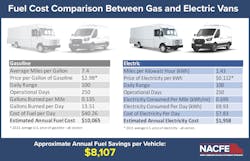NACFE demonstrates use case for electric vans and step vans
The North American Council for Freight Efficiency (NACFE) and RMI’s latest research shows that vans and step vans in the U.S. and Canada are 100% electrifiable today. NACFE’s Run on Less – Electric demonstration has shown that the technology is mature enough for fleets to invest in battery-electric vans and step vans.
The latest report from NACFE and RMI, Electric Trucks Have Arrived: The Use Case for Vans and Step Vans, released on April 12, calculates that electrification of vans and step vans would result in avoiding the emission of about 43.5 million tons of CO2e annually, equivalent to removing nearly 5 billion gallons of gasoline from the U.S. economy per year. Most easily recognizable as package delivery vehicles, vans and step vans constitute about half of all registered commercial vehicles in North America.
“As recently as five years ago, I would have questioned the feasibility of electrifying North American van and step van fleets,” said Mike Roeth, NACFE’s executive director. “The transition to cost parity happened quicker than most of us expected, and I’m as surprised as many to announce today that the electric market has arrived.”The report points out that ecommerce is doubling the van and step van market. The continued growth of ecommerce, coupled with customer demand for faster, cheaper shipping, and the need for last-mile delivery solutions, will likely drive growth in the van and step van market segment over the next decade, according to NACFE. The case for electrification includes a cost analysis of the vehicles themselves, energy usage, maintenance, and sustainability metrics.
Everything around electrifying smaller commercial vehicles is easier, and the TCO for this market segment is approaching parity with diesel- and gasoline-powered vehicles, NACFE also noted in its findings. Battery technology today meets the operational requirements for smaller commercial vehicles, especially in the Classes 3-6 range, NACFE added.
“The battery packs are smaller and don’t impact cargo capacity or payload,” according to the report. “Additionally, because these vehicles are typically used in single-shift operations, fast charging is not necessary. This lowers the power requirements, thereby reducing the total cost of charging and infrastructure.”
See also: NACFE chooses 13 fleets and BEVs for Run on Less Electric
Another finding from the report centers around improved driver attraction and retention. Aside from reliability and improved working environment benefits, NACFE pointed out that drivers have said they get a lot of interest about the electric vehicles they are driving, from both their peers and their families.
Although electrifying smaller commercial vehicles is easier, the transition will still be difficult, according to the report.
“Electrification will not happen overnight or in a silo,” NACFE stated. “Redesigning parking lots and depots to support electrification will take time, effort, and money. Thoughtful planning during the design phase at new sites can help fleets mitigate some of the challenges existing sites will experience as they work toward electrification.”The Run on Less – Electric demonstration focused on the van and step van segment of the trucking industry in addition to medium-duty box trucks, terminal tractors, and heavy-duty regional haul tractors.
The three fleet-OEM pairs in the van segment were:
- DHL with a Lightning eMotors Ford Transit 350 HD Class 3 van
- Purolator with a Motive EPIC Class 6 step van
- Servall Electric with a Workhorse C1000 Class 4 step van
The report uses findings gathered from the real-world truck demonstration, Run on Less – Electric (conducted in September 2021). It shares the methods used to select the participating fleets, routes, and equipment, the measured metrics, and details of the Run’s findings and lessons learned.
About the Author
FleetOwner Staff
Our Editorial Team
Kevin Jones, Editorial Director, Commercial Vehicle Group
Josh Fisher, Editor-in-Chief
Jade Brasher, Senior Editor
Jeremy Wolfe, Editor
Jenna Hume, Digital Editor
Eric Van Egeren, Art Director



